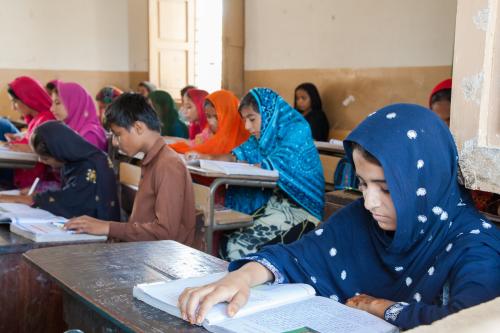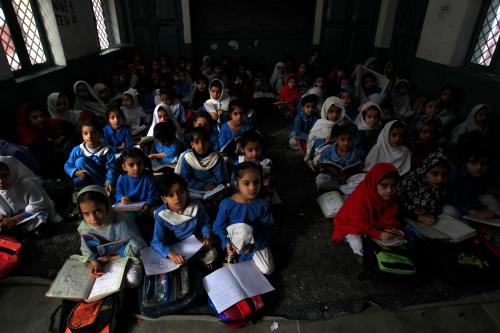Editor’s Note: The #GirlsEdu blog series is a collection of posts discussing girls’ education and the challenges it faces around the world. On June 17, Brookings will host “Celebrating Progress, Remaining Steadfast and Asking What’s Next for Girls’ Education,” at which these themes and more will be explored by the blog authors and other prominent experts. Register to attend or watch the webcast here.
When I was growing up in a remote village in the mountains of northern Pakistan, getting an education was an impossible dream for someone like me. I contracted polio when I was less than a year old and was never able to walk. Having a child with a disability was considered a disgrace in my community and therefore I was not allowed to be in public, even to go to school. It wasn’t just children with disabilities whose families refused to send them to school. My sister and other girls in my village were prevented from going to school too, as the local mindset at the time was that educating girls was a sin. Extreme poverty also prevented parents from sending children to school. In my valley, subsistence farming is the only hope of survival for many families and they are forced to make difficult economic decisions regarding education, which in the past resulted in sending boys to school to become the future bread-winners and keeping girls at home since they would become the “property” of another family once married.
In the past, this “lack of demand” for education meant that the government did not have to provide education for all children. Government schools were built more for boys than girls, in some communities at a ratio of 10 to one. But for the current generation in Pakistan, these mindsets are changing. Even in the most remote villages, parents want to send their children to school, including their girls and children with disabilities. However, in many villages there are no co-educational or girls schools available. Some send their girls to low-fee private schools that are of varying quality and often run by entrepreneurs who take advantage of the fact that parents are illiterate and unable to assess the school quality. For children with disabilities, most schools lack accessible entrances, toilets and teachers who are trained to support their needs.
There are 5.5 million children out of primary school in Pakistan, of which 62 percent are girls. Data on disabilities are inconsistent in Pakistan, but the most recent estimates are that 18 million people have some kind of disability in Pakistan, which is much higher than the 1998 national census figure of 2.5 percent of the population. Only 4 percent of children with disabilities are estimated to be enrolled in special education centers in the country. My organization, GRACE Association, recently conducted a survey in five valleys in Gilgit-Baltistan, the northeastern-most part of Pakistan. Of the more than 25,000 children, at least 1200 (5 percent) have identified disabilities and 88 percent of them are not yet enrolled in school. The data we gathered on girls reflect the national figures: 43 percent of children in these rural valleys are not enrolled in school, of which 60 percent are girls.
The greatest challenge in our communities is no longer changing mindsets. Rather, we need to drastically increase resources to meet this new demand for girls and children with disabilities through upgrading school facilities, hiring good teachers, and improving the quality of learning.
The founding members of GRACE Association have been working since 1992 to shift mindsets toward community development and education and now are focused on helping meet the demand for better schools. We are doing this by focusing programming on three areas:
- Making existing boys’ schools inclusive for girls and children with disabilities, through upgrading facilities (separate and accessible toilets, water supply, boundary wall, additional classrooms, ramps, etc.) and recruiting and training teachers;
- Establishing Community School Networks (CSNs) to develop local leadership and solutions to education issues; and
- Making learning a priority in schools, using regular assessments to evaluate student learning, individualize instruction and incentive teachers to help all children improve.
However, we face many challenges in our work. The story of Khar village illustrates the barriers to meeting this increased demand for schooling.
There are no schools that accommodate girls in Khar, only one boys primary school. The nearest co-educational school is too far away for parents to send their daughters. A number of children with disabilities live in the village, but the school has an irrigation channel in front of the facility and lacks accessible toilets, so it is ill-equipped for students with disabilities. The teachers were reluctant to enroll girls and children with disabilities because they did not feel able to meet their needs.
The community school networks in Kowardu reported these issues to GRACE Association, and we visited the village and met with community members and the parents, including those of two disabled children living nearest to the school. During this meeting, the parents reported that, upon attempting to enroll their children in the school, the school’s head teacher said that he “had no time to take care of their disabled children.” The parents reported that this caused them embarrassment, which prevented them from pursuing enrollment of their children.
The GRACE team visited the head teacher at his home and discussed the issue. He said that he recognized the importance of education for all children, but he needed help expanding the facilities, making the school building accessible and acquiring additional learning materials. He also needed to hire two teachers and build two more classrooms to accommodate the 70 girls in the village who wished to attend school. Between the community members and GRACE team, we had the resources to build the additional classrooms and begin enrolling students. All that we needed was an official letter from the government’s education department stating that he was authorized to enroll girls and children with disabilities and had no objection working with a NGO such as the GRACE Association to educate all children.
While my team worked to construct a culvert across the irrigation channel and a wheelchair accessible ramp into the building, I went to the provincial secretariat of education to meet with secretary of education at Gilgit. I received verbal appreciations for the work we are doing and was told to expect an official letter soon. That was in October 2013. Though we are following up, no letter has yet been received. And thus the 70 girls and children with disabilities in Khar village are still waiting to go to school.
We are hopeful that this situation will be resolved soon and the upgraded Khar village school will serve as a model for other communities. However, without strong support from the government, we will have to continue fighting for schools to provide inclusive education one school at a time. International commitments are critical, but cannot take the place of domestic investment in education. Pakistan spends just 2 percent of GDP on education, which is insufficient to meet the learning needs of even those children currently enrolled in schools, let alone the 5.5 million out-of-school children. The times have changed in Pakistan, and girls like Malala are even willing to risk their lives to go to school. It is time the government steps up its efforts and ensures the right to education for all Pakistani children.









Commentary
#GirlsEdu: Changing Mindsets and Aiming to Educate All Children in Pakistan
June 4, 2014